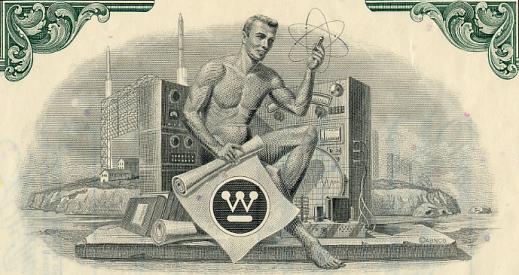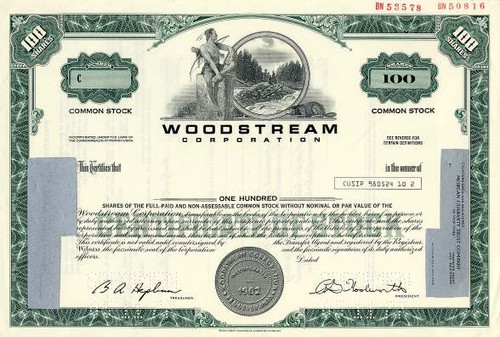Beautiful engraved specimen certificate from the Westinghouse Electric Corporation printed in 1971. This historic document was printed by the American Bank Note Company and has an ornate border around it with a vignette of a man holding an atom with electronic equipment and rockets in the background. This item has the printed signatures of the Company's President ( Dan Burnham) and Secretary ( R.B. Read ) and is over 46 years old. 
Certificate Vignette The Westinghouse Electric Corporation was an organization founded by George Westinghouse in 1886 as Westinghouse Electric & Manufacturing Company. The company purchased CBS in 1995 and was renamed CBS Corporation in 1997. George Westinghouse had previously founded the Westinghouse Air Brake Company. Westinghouse Electric received the rights for the first patent for alternating-current transmission from Nikola Tesla and unveiled the technology for lighting in Great Barrington, Massachusetts. The company pioneered long-distance power transmission and high-voltage transmission. In addition to George Westinghouse, engineers working for the company include William Stanley, Nikola Tesla and Oliver Schallenberger. It was historically the rival to General Electric. Timeline of company evolution 1889 - renames itself the Westinghouse Electric & Manufacturing Company 1893 - supplies electric lights and power for Chicago World Fair 1895 - installs hydropower AC generators at Niagara Falls which supplied power to Buffalo, NY 1899 - founds British Westinghouse Electric and Manufacturing Company 1901 - acquires Bryant Electric Company of Bridgeport, Connecticut, which continues operation as a subsidiary 1909 - ousts George Westinghouse as chairman during bankruptcy reorganization 1914 - acquires Copeman Electric Stove Company and enters the home appliance market (sold in 1974 to White Consolidated Industries) 1915 - New England Westinghouse Company opens for business. First product: rifles for the Czar's army. 1916 - share of British Westinghouse purchased by a British holding company, which becomes Metropolitan-Vickers 1920s - enters the broadcasting industry, with stations like KDKA in Pittsburgh, Pennsylvania 1930s - enters the nuclear age with an industrial atom smasher. 1940s - enters aviation with airborne radar (defense electronics sold 1996), jet engine propulsion, and ground based airport lighting. 1945 - renames itself the Westinghouse Electric Corporation, and makes first automatic elevator. 1950s - enters consumer finance with Westinghouse Credit Corporation 1960s - acquires ThermoKing, begins automated mass transit (sold 1988) 1970s - sells well-known appliance division to White Consolidated Industries which becomes White-Westinghouse 1980s - acquires cable television operator TelePrompter (sold 1985) and robot maker Unimation; sells street light division to Cooper Lighting, elevator/escalator division to Schindler Group, and lamp division to Philips. 1989 - sells watthour meter division at Raleigh, North Carolina to Asea Brown Boveri Group. 1993 - Completes $80MM Ground Segment Deal with American Mobile Satellite Corporation negotiated by Herb Nunally and Bob Kerstein. 1994 - sells electric power distribution and control business unit to Eaton Corporation for $1 billion. 1995 - buys CBS for US$5.4 billion. 1996 - buys Infinity Broadcasting 1996 - sells Westinghouse Electronic Systems defense business to Northrop Grumman for $3 billion, becoming Northrop Grumman Electronic Systems. 1997 - sells most non-broadcast operations; renames itself CBS Corporation 1998 - sells remaining manufacturing asset, its nuclear business, to BNFL who sold it to Toshiba in 2006 who still operates it as Westinghouse Electric Company today. 1998 - CBS Corporation creates a new subsidiary called Westinghouse Electric Corporation to manage the Westinghouse brand. 1999 - sells itself to Viacom, Inc. History from Wikipeida and OldCompanyResearch.com. About Specimen Certificates Specimen Certificates are actual certificates that have never been issued. They were usually kept by the printers in their permanent archives as their only example of a particular certificate. Sometimes you will see a hand stamp on the certificate that says "Do not remove from file". Specimens were also used to show prospective clients different types of certificate designs that were available. Specimen certificates are usually much scarcer than issued certificates. In fact, many times they are the only way to get a certificate for a particular company because the issued certificates were redeemed and destroyed. In a few instances, Specimen certificates were made for a company but were never used because a different design was chosen by the company. These certificates are normally stamped "Specimen" or they have small holes spelling the word specimen. Most of the time they don't have a serial number, or they have a serial number of 00000.

Certificate Vignette








